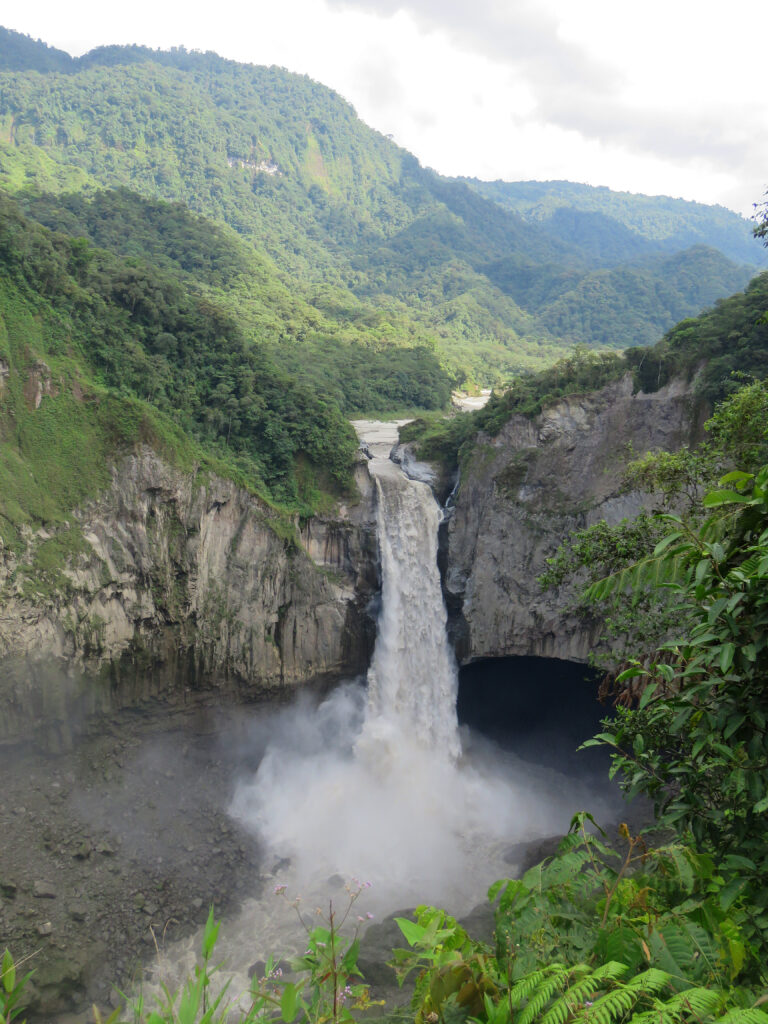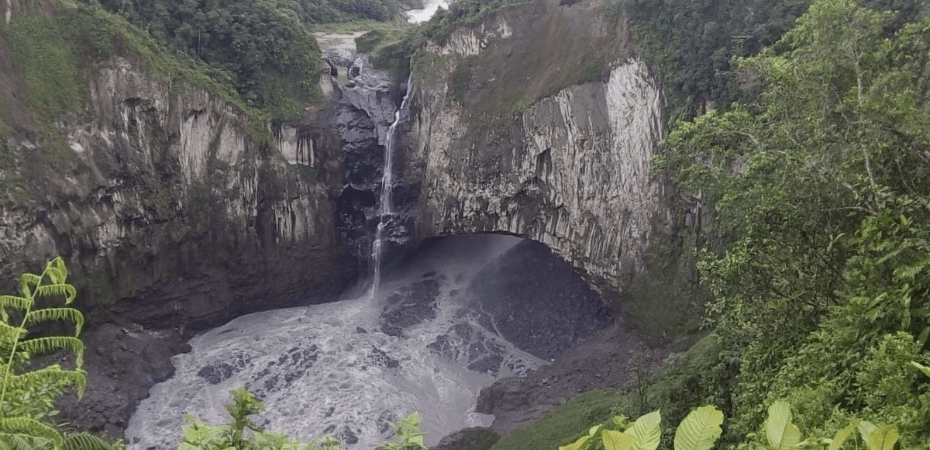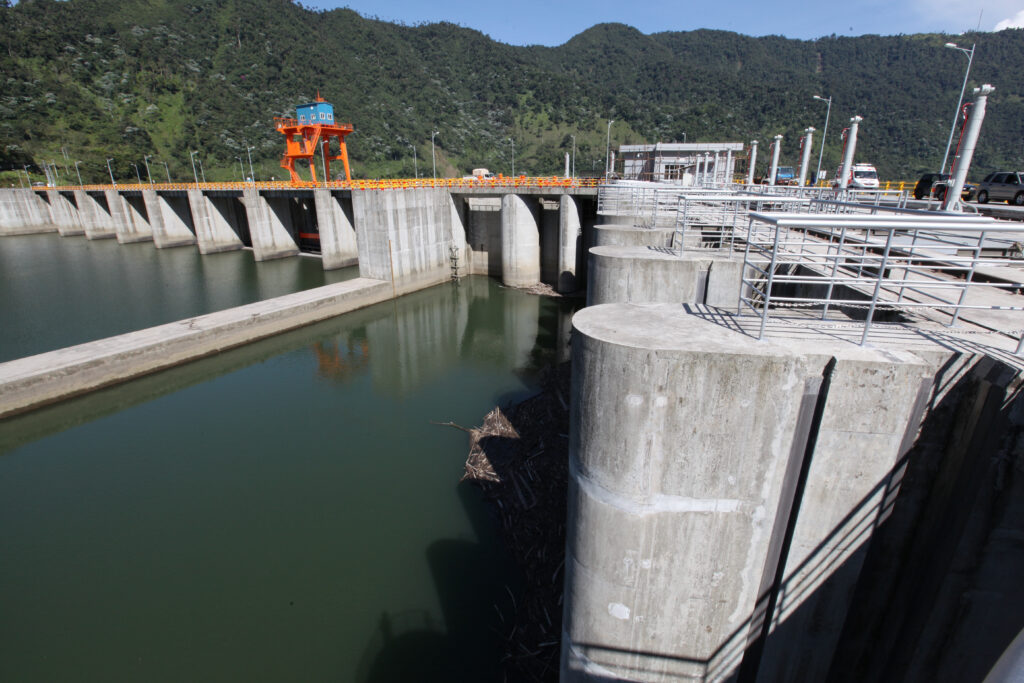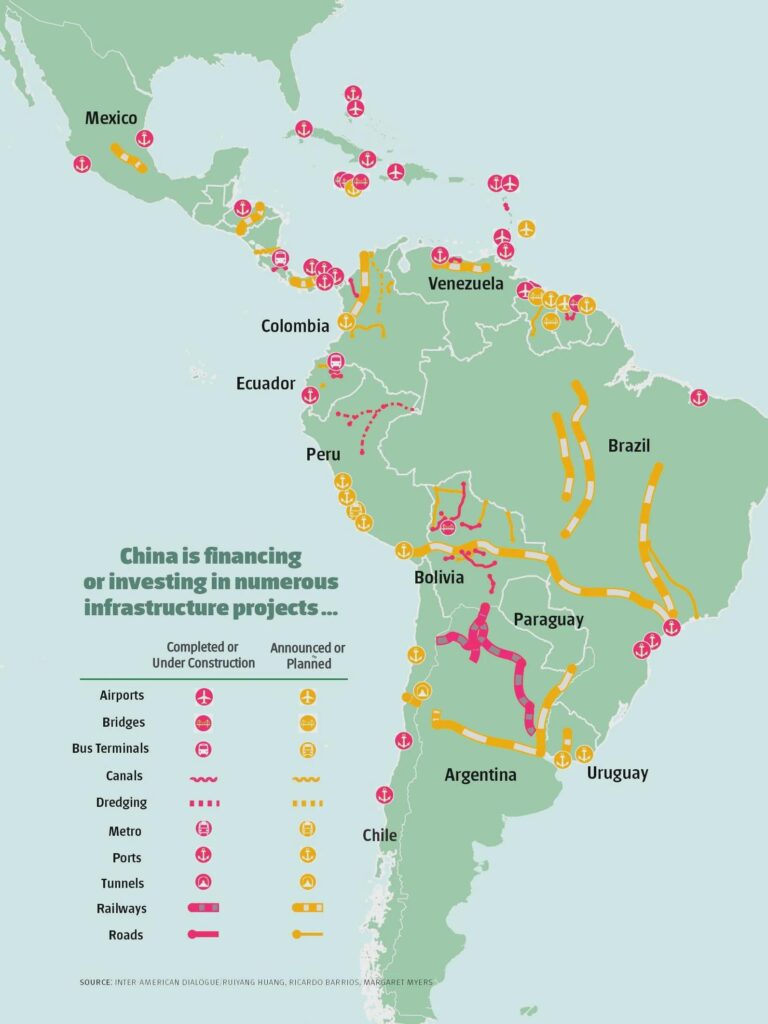STUDENT RESEARCH
SINCE THE LAUNCH OF CHINA’S Belt and Road Initiative in 2013, Chinese economic presence in Latin America has expanded dramatically, signaling a new phase in Sino–Latin American collaboration. The initiative, short for the Silk Road Economic Belt and the 21st Century Maritime Silk Road, aims to foster China’s global leadership and regional integration through economic ties and infrastructure development across Eurasia and beyond.1 Marketed as part of a win-win model of South-South cooperation that promises sustainable development, emerging China-backed megaprojects are not uncontentious, and have triggered environmental degradation, community displacement, and debates over the true meaning of “development.”
In Latin America, the concept of Buen Vivir complicates these global partnerships. Buen Vivir, or “good life,” is a recognized alternative development model rooted in Indigenous worldviews that stress collective well-being in harmony with nature, non-human beings, and the earth. Ecuador and Bolivia even added it to their constitutions, along with rights of nature, in 2008 and 2009 respectively. These conflicting goals are not simply about a foreign power imposing its will. They reflect deeper struggles over state policies, local governance, and competing visions of progress. What happens when constitutional promises of Buen Vivir are reconciled with extractive industries backed by both global capital and local governments? And how do Indigenous communities and other marginalized groups resist and redefine their futures amid these tensions?

When Development Dries Up Rivers and Rights
The Coca Codo Sinclair Dam (CCS) in Ecuador’s Amazon region was once celebrated as a symbol of modernity and development. Financed and built by the Chinese state-owned company Sinohydro, the CCS promised clean energy and progress, and is emblematic of former Ecuadorian president Rafael Correa’s neo-extractivist administration, which promoted exportation of natural resources as the pathway to poverty reduction.
But beneath these promises, the project disrupted more than river flows. By altering the Coca River’s natural flow patterns, the dam caused significant sediment loss, leading to the sudden disappearance, on February 2, 2020, of the country’s tallest waterfall, Cascada San Rafael, located 19 km downstream. Five days later, a massive sinkhole upstream of the waterfall ruptured three pipelines, spilling some 15,000 barrels of crude petroleum and contaminating water sources vital to approximately 120,000 members of 105 Kichwa and Shuar2 Indigenous communities.

With limited access to modern technologies or knowledge about environmental licensing and their legal rights, local residents have struggled to hold any party accountable. They feel that the dam has offered more unmet promises than solutions. Despite Ecuador’s constitutional commitments to environmental protection and Indigenous rights, the state neglected to fully evaluate the risks of the project in its early phases. It dismissed independent environmental assessments as bureaucratic burdens and hurdles, and expert and civil society concerns as “politically motivated nonsense.”3
The harm to Indigenous communities goes beyond the purely physical. Construction of the dam also destroyed sites considered sacred in the Shuar cosmovision. Areas of water and land that nurture and support Shuar spiritual practice, and house the spirits of their ancestors, have been degraded. Ironically, while the energy generated by the dam primarily serves distant urban and industrial centers, the Indigenous communities most affected by the project remain without reliable electricity. For whom is development being realized, what kind of development is it, and at what cost?

Toxic Waters and Displaced Futures
In the southern Ecuadorian Amazon, the Mirador copper mine is the first and biggest open-pit mine in Ecuador. Operated by the Chinese company EcuaCorriente S.A., the mine tells a similar story of broken promises. Local communities have reported changes in river color and declining water quality, while Shuar families face forced removal and dispossession from their ancestral land. Beyond transforming agricultural practices, the mine has deployed state police in the illegal displacement of Indigenous people. It has also destroyed Indigenous archaeological sites, disrupted their social structure and cultural practices, and its actions essentially constitute a violation of collective rights of the local communities. As a result, the Mirador mine has left a wake of fractured social cohesion and created internal divisions and mistrust.
The Ecuadorian government often frames such infrastructure projects as part of Ecuador’s post-neoliberal path toward prosperity. In practice, the constitutional guarantee of Buen Vivir is frequently overridden by the state’s legal ownership of all subsoil resources. This allows extractive industries to operate outside of legal environmental licensing procedures, even when local communities oppose them.
When the right to well-being comes into conflict with state practices, the concept of cuerpo-territorio (body-territory) takes on relevance. Proponents of this concept embrace the notion that “what the body experiences is simultaneously experienced by territory” subject to resource extraction. In response, scholars have turned to body-mapping as an arts-based visceral method to illustrate—through drawings—the embodied and emotional-spatial experiences of marginalized groups facing extractive violence. Body-mapping gatherings help people whose perspectives are often marginalized to reclaim narrative and agency, thus challenging extractivist logics. Using body-mapping, LLILAS alumna Nohely Guzmán Narváez vividly showed how new road construction and the presence of outsiders, particularly Chinese strangers, caused fear and anxiety among Indigenous children in Bolivia.4
The Ghost Town Left Behind
Across Latin America, communities continue to grapple with the effects of development models shaped by the intertwined forces of global capital and state policy. The story of Morococha, a mining town in the Peruvian Andes, captures this entanglement clearly: the promise of national progress and corporate investment has come at the cost of displacement, community rupture, and long-term health risks.
Morococha has historically been a mining town, where urban infrastructure and social life have long been subordinated to the interests of mining companies. The town’s mixed-background residents share a strong identity as miners and workers, with a deep attachment to the town. Starting in 2016, the Aluminum Corporation of China (Chinalco) relocated over 95 percent of Morococha’s 5,000 residents to a newly built settlement, Nueva Morococha, to make way for open-pit mining. The Peruvian state, through agencies like SENACE (National Environmental Certification Service for Sustainable Investments), approved the project and helped enable the relocation process. Chinalco even hired a private firm to manage the transition. Promised modern housing, schools, and jobs, many displaced residents instead found only isolation and unfulfilled commitments.
Twenty-five families refused to leave. They remain in the old Morococha, now a near ghost town cut off from basic services. For these residents, the loss is not just physical but existential—the erasure of a place that held their history, identity, and community, and gave them a sense of belonging. Some of the children were discovered to have elevated levels of lead in their blood. The families formed an alliance for collective action and accused Chinalco and SENACE of violating their human rights and harming their health and environment.

Labor and Cultural Clashes
Beyond environmental and territorial impacts, Belt and Road infrastructure projects often reshape the workplace and social relations in ways that reveal deeper cultural and structural tensions. In several Chinese-operated sites across Latin America, labor disputes have emerged not just over wages or safety, but over divergent expectations and values. Chinese companies have at times viewed local workers as unmotivated, undisciplined, and frequently reporting labor rights violations.
In a study on misunderstanding in a transnational workplace by LLILAS alumna Rui Jie Peng, PhD, one Chinese interviewee described local workers as smart and meticulous, quick to learn, and finishing work more carefully than Chinese workers—but unwilling to do extra work. Local employees, on the other hand, felt that Chinese workers spoke too loudly and directly, and came across as bossy or condescending. They accused Chinese people of being workaholics, emotionless, and showing disregard for labor laws and conditions. Such conflicts reflect a broader pattern: While projects are often framed as technical or apolitical enterprises, they are in fact deeply embedded in cultural, legal, and social contexts. Peng has argued that the stereotypical readings of Chinese workers often ignore the labor and cultural constraints they are subject to.5 In the absence of state protection in the workplace, they consider strict surveillance in their personal lives as necessary for ensuring their safety and work performance, following a “tough hydro-worker” ethic of obedience to authority, loyalty, and integrity. On the other hand, the Ecuadorian government has institutionalized protections for Ecuadorian workers to justify its legitimacy, leading to an increase in protests and demands on management among local workers.
The failure of many Chinese companies to invest in cross-cultural understanding or adapt workplace expectations often reinforces a silent divide, one rarely acknowledged in official narratives of partnership or cooperation. Years ago, during a visit to a Chinese company’s cafeteria in Mexico, I noticed an invisible boundary: Chinese employees and local employees lined up at separate food counters, sat on opposite sides of the room, and rarely interacted with each other. Though physically in the same space, they occupied parallel worlds. At one point, a Chinese employee remarked that learning Spanish was unnecessary—he was “just here to work.” While today many companies offer language learning to both local and Chinese employees, the effectiveness of these efforts remains understudied.
These quiet divisions, reinforced by language, behavior, and routine, show how global partnerships can reproduce social distance. Even as infrastructure projects promise cooperation and shared prosperity, they often fail to foster meaningful connection between those working side by side.
Development for Whom? Broken Promises and Epistemic Complexity
The cases described above expose the contradictions at the heart of the development models in parts of Latin America. While Buen Vivir enshrines harmonious living and the rights of nature in national constitutions, these same constitutions also assert state ownership over all subsoil resources. This legal framework legitimizes extractive projects in the name of national interest, even when they directly violate the principles of Buen Vivir.
Such contradictions reflect a deep Eurocentric and racial logic embedded in state policy and narratives about development—one that “others” and romanticizes Indigenous peoples as ahistorical guardians of nature while denying them agency over their territories and futures. Development becomes a colonial discourse embellished with the language of sustainability and inclusion.
In tracing the environmental, socio-cultural, and epistemological impacts of China’s Belt and Road Initiative across Latin America—especially Ecuador—this article reveals a development model fraught with contradictions. While infrastructure and extractive investments are framed as engines of progress, they often erode ecological stability, displace Indigenous communities, and perpetuate hierarchies of knowledge and value, especially along racial lines. The recurring violations of consent, environment, and human rights speak not only to governance failures but to deeper patterns of inequality that are built into today’s global development model. Local resistance—from legal battles to body-mapping—shows how Indigenous communities are not passive victims but active agents who redefine what development can and should mean. Reimagining development and Buen Vivir in this context demands questioning long-held ideas about progress, territory, and the very purpose of public infrastructure. ✹
Notes
1. Paul Amar et al., eds. The Tropical Silk Road: The Future of China in South America (Stanford, CA: Stanford University Press, 2022).
2. The Kichwa had contact with outsiders as early as the 1600s and are missionized, with extensive cultural hybridization. The Shuar distinguish themselves from other Amazonian Indigenous groups by their late contact with mestizo settlers, which did not occur on a large scale until the 1950s. As a result, the Shuar maintain a largely traditional lifestyle—relying on fishing and horticulture as their primary sources of food—and cultural and territorial autonomy. They also maintain a strong territorial defense and resistance to colonization.
3. K. van Teijlingen and J.P. Hidalgo-Bastidas, “A Mine, a Dam, and the Chinese-Ecuadorian Politics of Knowledge,” in The Tropical Silk Road, 233–244. doi.org/10.1515/9781503633810-018
4. Nohely Guzmán Narváez, “Embodied Geographies: Feminist Body-Mapping with Amazonian Indigenous Girls, Cuerpo-Territorio, and the Outlining of a New Academic Grammar,” Portal, September 2022.
5. Rui Jie Peng, “Constructing hydropower: labor control in Chinese transnational hydroelectric projects in Ecuador,” master’s thesis, Department of Sociology, College of Liberal Arts, The University of Texas at Austin, 2015.
